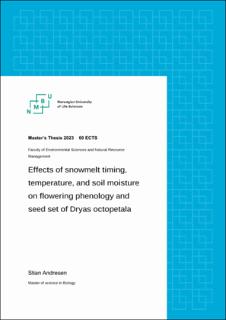| dc.description.abstract | Climate change advances the timing of life-cycle events (i.e., phenology) in plants, especially in cold biomes where the temperatures have increased twice as fast as in other biomes. In cold biomes, warmer temperatures will lead to earlier snowmelt and the risk of drought increases. These environmental conditions will differ on a small scale due to the topography and affect the timing of flowering. However, understanding which environmental factors influence phenology and how climate may impact those factors is important for predicting potential responses in alpine plant communities.
The main objective of this study is to examine how the flowering phenology and seed set of Dryas octopetala at Finse, Norway, are driven by snowmelt timing, ground surface temperature, and soil moisture. There were established 25 plots in three different elevations: low, middle, and high. Using time-lapse cameras and climatic loggers, I calculated the date of onset flowering, day of snowmelt, duration of the prefloration interval from snowmelt to the onset of open flowers (prefloration interval), average ground surface temperature, average soil moisture, and seed sets (%).
I found that plots with earlier snowmelt timing had an earlier flowering onset. The length of the prefloration interval was shorter at plots with warmer average temperatures and greater average soil moisture in the prefloration interval, as well as plots with delayed snowmelt. Plots at the middle elevation had an earlier snowmelt timing than the high elevation. The ground surface after snowmelt decreased with increasing elevation, and soil moisture was greater at the low elevation than at the middle elevation. There was no significant difference in seed sets among the three elevations, even though seed sets tended to decrease with elevation. These results suggest that earlier snowmelt will advance the date of onset flowering of D. octopetala. However, earlier snowmelt will only majorly impact the flowering phenology if the temperatures increase in the prefloration interval. | |
